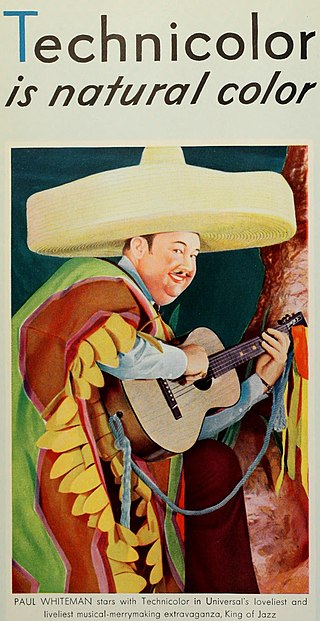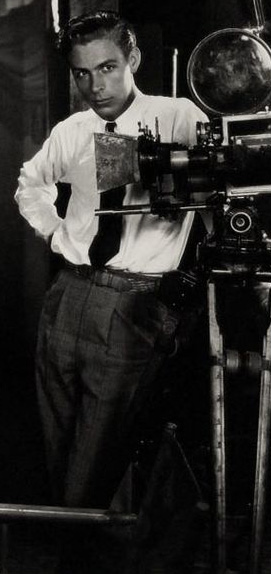
The Hollywood Revue of 1929, or simply The Hollywood Revue, is a 1929 American pre-Code musical comedy film released by Metro-Goldwyn-Mayer. It was the studio's second feature-length musical, and one of their earliest sound films. Produced by Harry Rapf and Irving Thalberg and directed by Charles Reisner, it features nearly all of MGM's stars in a two-hour revue that includes three segments in Technicolor. The masters of ceremonies are Conrad Nagel and Jack Benny.

35 mm film is a film gauge used in filmmaking, and the film standard. In motion pictures that record on film, 35 mm is the most commonly used gauge. The name of the gauge is not a direct measurement, and refers to the nominal width of the 35 mm format photographic film, which consists of strips 1.377 ± 0.001 inches (34.976 ± 0.025 mm) wide. The standard image exposure length on 35 mm for movies is four perforations per frame along both edges, which results in 16 frames per foot of film.

Universal Pictures is an American film production and distribution company owned by Comcast through the NBCUniversal Film and Entertainment division of NBCUniversal.

Biograph Studios was an early film studio and laboratory complex, built in 1912 by the Biograph Company at 807 East 175th Street, in The Bronx, New York City, New York.

Cinecolor was an early subtractive color-model two-color motion picture process that was based upon the Prizma system of the 1910s and 1920s and the Multicolor system of the late 1920s and the 1930s. It was developed by William T. Crispinel and Alan M. Gundelfinger, and its various formats were in use from 1932 to 1955.

Petro Vlahos was an American engineer and inventor, considered to be one of the pioneering scientific and technical innovators of the motion picture and television industries. He is remembered in particular for creating the Ultimatte process, which refined the colour process known as chroma keying. In recognition of his contributions, he was awarded multiple Oscars, as well as an Emmy Award.

Herbert Thomas Kalmus was an American scientist and engineer who played a significant role in developing color motion picture film. Kalmus was the co-founder and president of the Technicolor Motion Picture Corporation.
LaserPacific Media Corporation was a television and motion picture post-production facility operating in Hollywood, Burbank, Calif., New York, and in Vancouver, Canada. Laser-Pacific was formerly a publicly traded corporation, prior to being a subsidiary of Eastman Kodak (2003-2010), prior to being owned by HIG Capital (2010-2011), and bought by Technicolor SA in 2011.

Color motion picture film refers both to unexposed color photographic film in a format suitable for use in a motion picture camera, and to finished motion picture film, ready for use in a projector, which bears images in color.
Eastmancolor is a trade name used by Eastman Kodak for a number of related film and processing technologies associated with color motion picture production and referring to George Eastman, founder of Kodak.
Trucolor was a color motion picture process used and owned by the Consolidated Film Industries division of Republic Pictures. It was introduced as a replacement for Consolidated's own Magnacolor process.

Deluxe Media Inc., also known simply as Deluxe and formerly Deluxe Entertainment Services Group, Inc., is an American multinational multimedia and entertainment service provisions company owned by Platinum Equity, founded in 1915 by Hungarian-born American film producer William Fox and headquartered in Burbank, California.
In bipack color photography for motion pictures, two strips of black-and-white 35 mm film, running through the camera emulsion to emulsion, are used to record two regions of the color spectrum, for the purpose of ultimately printing the images, in complementary colors, superimposed on one strip of film. The result is a multicolored projection print that reproduces a useful but limited range of color by the subtractive color method. Bipack processes became commercially practical in the early 1910s when Kodak introduced duplitized film print stock, which facilitated making two-color prints.
The Centaur Film Company was an American motion picture production company founded in 1907 in Bayonne, New Jersey, by William and David Horsley. It was the first independent motion picture production company in the United States. In 1909 the company added a West Coast production unit, the Nestor Film Company, which established the first permanent film studio in Hollywood, California, in 1911. The company was absorbed by the Universal Film Manufacturing Company in 1912.
DeLuxe Color or Deluxe color or Color by DeLuxe is Deluxe Laboratories' brand of color process for motion pictures. DeLuxe Color is Eastmancolor-based, with certain adaptations for improved compositing for printing and for mass-production of prints. Eastmancolor, first introduced in 1950, was one of the first widely-successful "single strip color" processes, and eventually displaced three-strip Technicolor.

Technicolor is a series of color motion picture processes, the first version dating back to 1916, and followed by improved versions over several decades.
Technicolor Special was a common term used for Hollywood studio produced color short films of the 1930s and 1940s that did not belong to a specified series.
Alan Eliot Freedman was a pioneer and long-time executive in the motion picture film processing industry. He founded DeLuxe Laboratories after serving as president of its predecessor, Fox Film Laboratories. His career lasted over 50 years.

Edward Cronjager was an American cinematographer whose career spanned from the silent era through the 1950s. He came from a family of cinematographers, with his father, uncle, and brother all working in the film industry behind the camera. His work covered over 100 films and included projects on the small screen towards the end of his career. He filmed in black and white and color mediums, and his work received nominations for seven Academy Awards over three decades, although he never won the statue.

Cinema Research Corporation (CRC) was an American special effects company in Hollywood, California, and one of the first to produce effects, trailers, opticals, and titles under one roof. The company was the special effects industry leader for decades, until Industrial Light and Magic surpassed them in the late 1980s. In 1990, CRC began to concentrate its efforts on titles and opticals, and became the industry leader in those categories, by providing the titles and opticals for over 400 productions in the decade before the CEO's passing in 2000.











